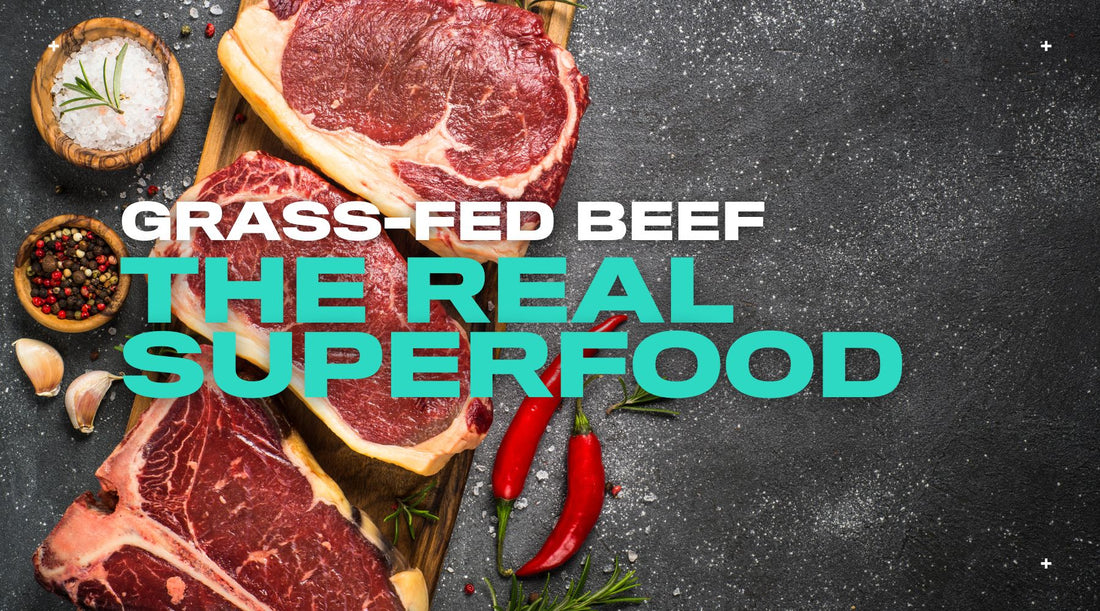
Should Grass-Fed Beef Be a Superfood?
It’s nutrient-dense, performance-boosting, and cleanly raised - so why aren’t more people calling it what it is?
There’s no shortage of “superfoods” in the wellness world; chia seeds, kale, goji berries, and açai have all had their time in the spotlight. But if we’re judging by nutrient density, functionality, and bioavailability, grass-fed beef might be the most overlooked superfood on your plate (or in your pocket).
In this article, we break down exactly why grass-fed beef should be a superfood, from its complete protein profile to its abundance of iron, B vitamins, omega-3s and CLA (conjugated linoleic acid).
We’ll also explore its benefits for recovery, strength, and long-term health, plus why Roam’s snacks are setting the standard for clean, pasture-raised protein in a modern, functional format.
What Makes Grass-Fed Beef Different?
Not all beef is created equal. Grass-fed cattle eat a natural, pasture-based diet, unlike grain-fed cattle often raised in feedlots on corn, soy, and by-products.
Nutritional wins of grass-fed beef:
- Higher omega-3 fatty acids (anti-inflammatory, brain-boosting)
- More CLA, a fatty acid shown to support fat metabolism and immunity
- Richer in antioxidants like vitamin E and glutathione
- Denser in micronutrients like iron, zinc, selenium, and B12
- Better fat quality overall (lower omega-6 to omega-3 ratio)
When we talk about the protein in meat, grass-fed beef delivers one of the most efficient, complete sources available, containing all nine essential amino acids for muscle repair, hormone balance, and recovery.

How It Compares: Grass-Fed vs Grain-Fed
| Factor | Grass-Fed | Grain-Fed |
|---|---|---|
| Omega-3s | Higher | Lower |
| CLA | Higher | Lower |
| Saturated fat | Lower | Higher |
| Environmental impact | Regenerative potential | Higher emissions, monocrops |
| Antibiotic use | Rare | Common |
| Ethical sourcing | Pasture-raised |
Often confined/feedlot systems |
Beyond the highest protein content in meat, grass-fed beef wins on quality, ethics, and long-term sustainability.
Beef and Protein: A Functional Powerhouse for Strength & Recovery
Why is beef such a powerful protein?
- Complete amino acid profile (unlike many plant proteins)
- High in leucine - essential for muscle protein synthesis
- Rich in bioavailable iron and B12 (for energy and focus)
- Supports satiety and metabolic health
- Ideal for pre- or post-workout recovery
It’s no surprise that athletes, active professionals, and performance-focused individuals are looking beyond powders and into real-food protein sources, and beef leads the pack.

Roam: Grass-Fed Beef Snacks That Fit Your Life
Roam sources its beef from pasture-raised cattle in Germany and the Netherlands, farmed to the highest European welfare and sustainability standards.
Why Roam’s snacks hit the mark:
✅100% grass-fed beef
✅18–20g of protein per bar / 28-32g per bite pouch
✅ No sugar, no seed oils, no preservatives
✅ Non-GMO, gluten-free, dairy-free, soy-free
✅ Portable, functional, and built for modern performance
Whether you’re hitting the gym, stuck in meetings, or fuelling a recovery day—Roam gives you superfood-quality beef in a super convenient format.
→ Explore Roam’s Grass-Fed Protein Range

Final Word: Grass-Fed Beef Isn’t Just Protein - It’s Performance Nutrition
With its unmatched nutritional density, sustainable sourcing, and muscle-supporting power, grass-fed beef deserves a place among the true superfoods. Especially when it’s delivered in a clean, easy-to-digest format like Roam.
If you're searching for functional protein, not just more calories, Roam's snacks deliver the edge you need, naturally.
Real ingredients. Real strength. Roam freely.
Further Reading
Nutritional Comparisons Between Grass-Fed Beef and Conventional Grain-Fed Beef - UNDERSTANDING AG
Grass-Fed vs. Grain-Fed Beef — What’s the Difference? - HEALTHLINE